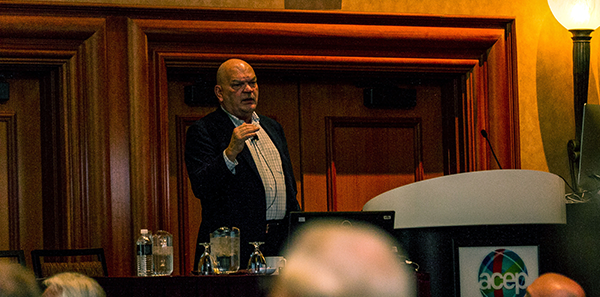
LAS VEGAS—In a month or two or six, when you’re back at work and the motivation from ACEP16 feels like it may cede to the burnout of daily life, look around your emergency department and try to notice a few things you normally wouldn’t.
Explore This Issue
ACEP16 Tuesday Daily NewsMaybe it’s seeing a boarded patient as an 85 year old whose life story would enthrall, rather than another elderly patient on a carousel to their nursing home. Or maybe it’s seeing a colleague give thanks to the oft-forgotten housekeeper for cleaning up after a particularly soiled patient.
Sometimes, the little things can be the simplest way to fight that proverbial burnout, or as James D. Mills Jr. Memorial Lecture presenter Thom Mayer, MD, FACEP, FAAP, called it, “the silent epidemic stealing our passion.”
“To combat burnout, we have to remember the power of one,” said Dr. Mayer, executive vice president of EmCare, founder and chief executive officer of BestPractices, Inc., the medical director for the NFL Players Association, and a clinical professor of emergency medicine at George Washington University, in Washington, D.C. and University of Virginia School of Medicine, in Charlottesville.
“One doc. One patient. One family. One team of people. One choice. Because when you walk into that patient’s room, you are going to make a difference…what’s that difference going to be?”
The session, “Loving the Job You Have While Creating the Job You Love,” was intended to give emergency physicians coping skills to take back home with them. The advice, in many ways, boils down to three questions-and-answers.
What do you love? Maximize that.
What do you tolerate? Minimize that.
What do you hate? Eliminate that.
To not ask those questions—nor pay attention to the self-reflective answers they might elicit—is to perpetuate the problem of burnout, Dr. Mayer said. The issue is even worse for those at the top of the specialty, as they’re the most affected.
“There’s a hidden cost to what we do,” he added. “The sad, unfortunate, and, perhaps, shocking thing about that is that those of us who care most, those of us who are most passionate, those of us who believe in what we do, are most at risk.”
People like Rochelle Chijioke Asagbra, MD, an emergency physician who just moved to Greenville, North Carolina. She acknowledged that from “time to time” she’s felt the buzzwords of burnout—feelings of inadequacy, feelings of unimportance. What she took from Dr. Mayer is keeping perspective.
“When you walk into the ER, when you’re going to work, it’s just having that mentality,” she said. “You’re there to have a legacy, you’re there to change lives. You’re there to make an impression on your patients, on your staff.”
Pages: 1 2 | Multi-Page




2 Responses to “Mills Lecture: Beware of Burnout”
October 18, 2016
RHPEELERThe fundamental problem regarding burnout is the inappropriate direct & indirect underfunding of the ED: inadequate emergency physician staffing for the extant patient volume / severity / acuity; inadequate nursing staffing; old, inadequate equipment.
What is the primary source of these unethical inadequacies?
When the average ED physician income is ~ $400K, as compared to the salary / bonus band of the C-suite [$500K – $20 Million], it is not difficult too ascertain that the compensation structure is upside down.
As our readers well know, depending on choice of specialty / fellowship, physicians attend medical school & train in residency / fellowship after high school graduation, for 12 – 17 years, whereas the C-suite crowd typically have at most an MBA (2.5 year committment), a not insignificant training difference of ~ 10 – 15 years.
[paragraph removed by editor]
The only effacacious method to rectify this obnoxious status quo with any sense of urgency, as far as I can project, is for the tens of thousands of EMPLOYED emergency physicians {as well as All other employed physicians, whether in practice or training}, is unfortunately to form employed physician >*UNIONS,*< whether nationally or in local / regional micro-aggregations.
Only then can we right-size & decompress our unwieldy workload so as to be able to actually ENJOY our patient encounters, obviate a large percentage of avoidable burnout, & get our comp back UP to where it should reasonably be, viz., $750 – 950K per year for EM, & $3 -5M per year for certain subspecialties with extended training periods, such as CardioThoracic & NeuroSurgery.
This will probably take ~ 5 years to accomplish, so we had best start ASAP.
The success of this movement will largely depend on altruistic retired or close-to-retirement physicians, who will not personally benefit from these changes.
If a positive pro-physician reversal is obtained, this momentum contra-centralization will also assist the reversal of current USA Corporate-Governmental Oligarchic Neo-Feudalism, in which the entire country finds itself.
October 18, 2016
BrianBurnout ate me for lunch. 14 years in a department that I planned to retire from…instead it drove me away. I swore I was going to be a worker bee in a small ED, instead I wound up quality committee chair, Med exec, and medical director. Angry patients, satisfaction scores, metrics, contract negotiations, short staff, inadequate nursing, angry consultants, boarding…I left the field and just secured a position in a dermatology practice. It does not matter where you work, it’s all the same. I cannot fathom what will happen when all the baby boomers hit their 80’s and are in the halls bemoaning how they ought be cared for and frankly don’t get what they deserve…expedient care.